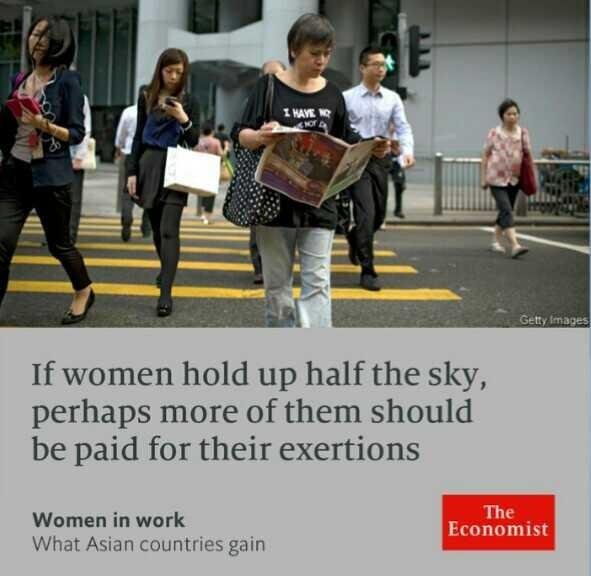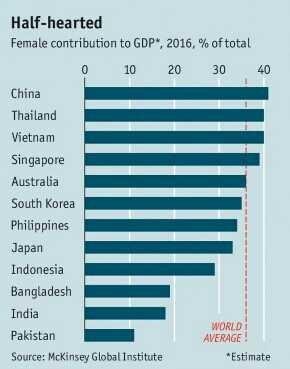
"WOMEN hold up half the sky,” Mao Zedong used to say, when not harassing peasant girls. They also hold up 41% of China’s GDP, the biggest share in the Asia-Pacific (see chart), says a new report by the McKinsey Global Institute, the consultancy’s think-tank.
In fact, Mao was subtly mistranslated, points out Perry Link, a China scholar. He actually said that women “can” hold up half the sky. McKinsey also thinks Asian women can make a bigger economic contribution. It finds “quite impressive” signs of progress in many countries, says Anu Madgavkar, one of the report’s authors. In Japan the percentage of women in the labour force has increased quickly in the past ten years; in the Philippines 142 women hold professional or technical jobs for every 100 men; China boasts 114 of the world’s 147 female, self-made billionaires (America has 14).
But China could add 13% to its GDP by 2025, relative to a baseline, if it increased women’s employment, hours and productivity as quickly as the leading countries in its region or peer group, McKinsey says. That would translate into an extra $2.6trn by 2025 (an economy the size of France). In India the relative gain could be even greater (18%), because it has far more room for improvement. McKinsey’s scenario would require 37% of Indian women to be in the workforce, up from 27% now.

But economic progress and female employment do not necessarily move in tandem. In India, as households have grown richer, women who might once have toiled in the fields have instead stayed in school or lived off the improved earnings of their male relatives. The most egalitarian employment rates in the region are found in two of its poorest countries: Myanmar and Nepal, where many women have no choice but to work as farmers.
McKinsey notes that GDP statistics understate women’s contributions. In China women did 73% of unpaid work (including child care, shopping and housework), according to the OECD. Women’s share is even higher in South Korea (83%), Japan (84%) and India (85%). What will happen to those unpaid hours if women’s paid work increases? McKinsey leaves the question open. Some of their chores may be left undone or be left to men (which is often the same thing). Some may be “outsourced” to professional cleaners, cooks and childminders, thereby becoming part of the increased GDP that McKinsey foresees. If women hold up half the sky, perhaps more of them should be paid for their exertions.
source: www.theeconomist.com
Hi! I am a robot. I just upvoted you! I found similar content that readers might be interested in:
http://media.economist.com/news/asia/21741192-getting-more-them-paid-work-would-hugely-boost-gdp-women-could-make-asia-rich